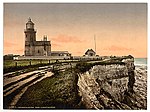Seahenge

Seahenge, also known as Holme I, was a prehistoric monument located in the village of Holme-next-the-Sea, near Old Hunstanton in the English county of Norfolk. A timber circle with an upturned tree root in the centre, Seahenge, along with the nearby timber circle Holme II, was built in the spring-summer of 2049 BC, during the early Bronze Age in Britain. Contemporary theory is that they were used for ritual purposes; in particular Holme II has been interpreted as a mortuary monument that may originally have formed the boundary of a burial mound. In order to preserve the timber in the site from exposure to air, due to recent exposure of the remains by the sea, it was excavated in Spring 1999, and its remains taken to an archeological museum and then a maritime museum for preservation of the wood. In 1999, a reproduction was put up by some of the excavators, near the site. In 2008, after further study, a second reproduction was erected near the original's location. Due to controversy about the excavation of Seahenge, Holme II was left in place to be monitored as it is gradually destroyed by erosion.
Excerpt from the Wikipedia article Seahenge (License: CC BY-SA 3.0, Authors, Images).Seahenge
Beach Road, King's Lynn and West Norfolk Holme next the Sea
Geographical coordinates (GPS) Address Nearby Places Show on map
Geographical coordinates (GPS)
| Latitude | Longitude |
|---|---|
| N 52.968055555556 ° | E 0.52138888888889 ° |
Address
Beach Road
PE36 6LG King's Lynn and West Norfolk, Holme next the Sea
England, United Kingdom
Open on Google Maps










